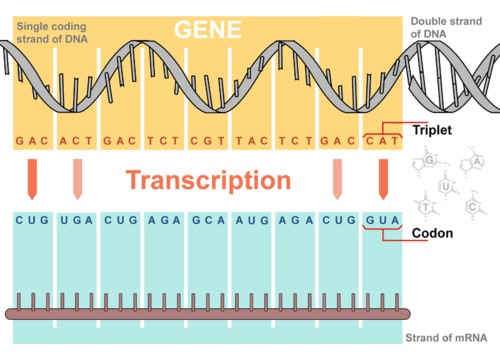Learning Outcomes
- Understand the basic steps in the transcription of DNA into RNA
The process of Transcription takes place in the cytoplasm in prokaryotes and in nucleus in eukaryotes. It uses DNA as a template to make an RNA (mRNA) molecule. During transcription, a strand of mRNA is made that is complementary to a strand of DNA. Figure 1 shows how this occurs. Eventually portions of the transcribed mRNA will be made into functional proteins.

Figure 1. Overview of Transcription. Transcription uses the sequence of bases in a strand of DNA to make a complementary strand of mRNA. Triplets are groups of three successive nucleotide bases in DNA. Codons are complementary groups of bases in mRNA.
Steps of Transcription

Figure 2. Transcription occurs in the three steps—initiation, elongation, and termination—all shown here.
Transcription takes place in three steps: initiation, elongation, and termination. The steps are illustrated in Figure 2.
Step 1: Initiation
Initiation is the beginning of transcription. It occurs when the enzyme RNA polymerase binds to a region of a gene called the promoter. This signals the DNA to unwind so the enzyme can ‘‘read’’ the bases in one of the DNA strands. The enzyme is now ready to make a strand of mRNA with a complementary sequence of bases.
Step 2: Elongation
Elongation is the addition of nucleotides to the mRNA strand. RNA polymerase reads the unwound DNA strand and builds the mRNA molecule, using complementary base pairs. During this process, an adenine (A) in the DNA binds to an uracil (U) in the RNA.
Step 3: Termination
Termination is the ending of transcription, and occurs when RNA polymerase crosses a stop (termination) sequence in the gene. The mRNA strand is complete, and it detaches from DNA.
This video provides a review of these steps. You can stop watching the video at 5:35. (After this point, it discusses translation, which we’ll discuss in the next outcome.)
Visit this BioStudio animation to see the process of prokaryotic transcription.
Try It
Candela Citations
- Transcription of DNA to RNA. Provided by: CK-12. Located at: http://www.ck12.org/biology/Transcription-of-DNA-to-RNA/lesson/Transcription-of-DNA-to-RNA-BIO/. License: CC BY-NC: Attribution-NonCommercial
- Transcription and Translation. Authored by: Bozeman Science. Located at: https://youtu.be/h3b9ArupXZg. License: All Rights Reserved. License Terms: Standard YouTube License
